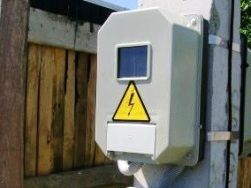Categories: Featured Articles » Electrician at home
Number of views: 29243
Comments on the article: 19
Once again about entering the power supply into the house. Deadly mistake
 The reason for writing the article was my viewing of several projects for the power supply of private houses. Designers are highly qualified specialists (he himself worked as a designer for 17 years), so I think that this is simply a misunderstanding, which should be corrected IMMEDIATELY.
The reason for writing the article was my viewing of several projects for the power supply of private houses. Designers are highly qualified specialists (he himself worked as a designer for 17 years), so I think that this is simply a misunderstanding, which should be corrected IMMEDIATELY.
Now essentially the problem. In connection with the new requirements, the connection of private residential buildings should be done through the metering panel, which is installed outside the house. In all projects, this was done according to the scheme shown in Fig. 1.
The analysis of this scheme does not withstand any criticism from the point of view of electrical safety of the residents of such a house. In case of malfunctions No. 1 and No. 3 (no contact) and malfunction No. 2 (PE wire break), the power supply to the apartment building will not be interrupted, and the protection circuits along the PE conductors will not work. Such an emergency can go unnoticed for a long time (until it shakes, it kills one of the tenants).

Fig. 1
Note. The figure shows only those elements that are necessary for understanding the essence of the problem.
The correct circuit is shown in Fig. 2.

Fig.2
Note. The figure shows only those elements that are necessary for understanding the essence of the problem.
The diagram shows that in emergency situations No. 1 No. 2 and No. 3, the accident is quickly detected (there is no electricity in the house) and will be quickly eliminated.
See also at bgv.electricianexp.com
:
